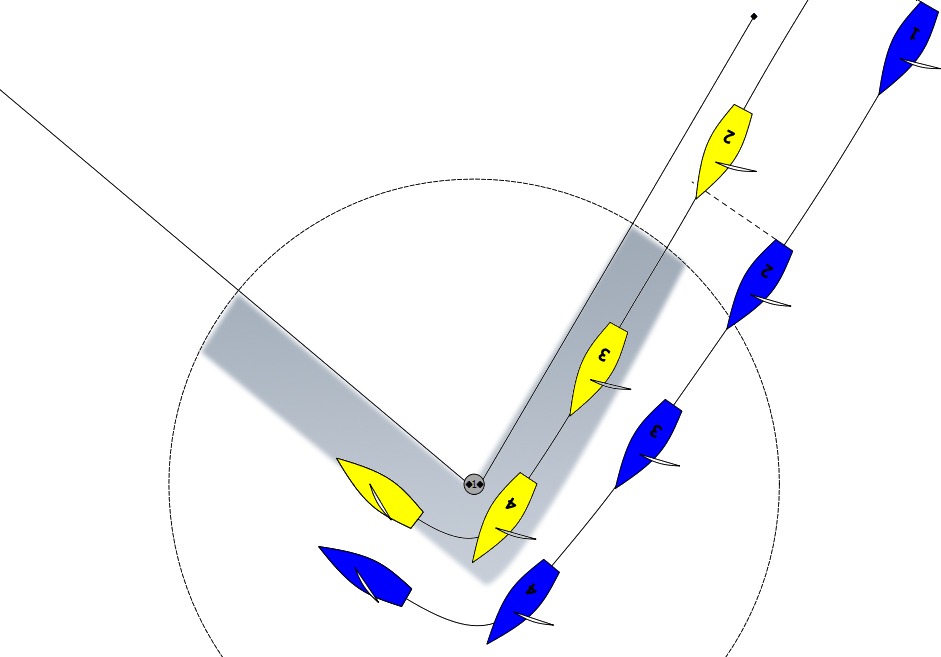RULE 18
MARK-ROOM
Introduction
Let’s remind ourselves where Rule 18 fits into the bigger picture. Rule 18 covers mark-room and still forms part of Part 2 (when boats meet) where you find it in Section C (marks and obstructions).
Rule 18 is all about mark-room. The rule is there because marks in general are bottlenecks where lots of boats converge. This applies especially to the first windward mark where boats are still relatively close together. Apart from the start, rounding marks is where things often go wrong. Rule 18 is there so we can round the mark effectively, in a fair manner, and safely.
In essence, Rule 18 puts an obligation on a boat to provide inside room to another boat when rounding a mark.
If Rule 18 demands it, the rule even applies when both boats are on the same tack and overlapped and where the inner boat is the windward boat. In that situation, the windward boat would normally need to keep clear of the leeward boat under Rule 11.
It is therefore important to understand that Rule 18 “sits on top” of more fundamental rules such as Rule 11 (windward/leeward). Rule 11 (among others) still applies so how is it possible for a windward boat to keep clear of a leeward boat and at the same time the leeward boat needs to give mark-room?
It is often a misunderstood concept. Many sailors believe that Rule 18 “trumps” Rule 11. This is not the case. In example 1, the windward boat still breaks Rule 11 but is exonerated for her breach.
So this is where we need to look at Rule 43. Rule 43 talks about exoneration. Rule 43(b) and Rule 43(c) specifically deal with exonerating boats affected by Rule 18.
Rule 43(b) When a boat is sailing within the room or mark-room to which she is entitled and, as a consequence of an incident with a boat required to give her that room or mark room she breaks a rule of Section A of Part 2, rule 15, 16, or 31, she is exonerated for her breach.
Rule 43(c) A right-of-way boat, or one sailing within the room or mark-room to which she is entitled, is exonerated for breaking rule 14 if the contact does not cause damage or injury.
Let’s have a quick graphical look at the principles surrounding Rule 18 and its relationship with Rule 43.
Do not worry too much about the technical application of Rule 18 because we cover this in detail later…

Instead of yellow keeping clear of blue, you can see that blue is bearing away and gives yellow mark-room. Yellow is still breaking Rule 11 but is exonerated (forgiven if you like) under Rule 43(b).
What else is important to know before we get into the nitty-gritty of Rule 18?
Well, the million-dollar question is “how much” room is mark-room? We can be guided by the rules themselves because we can find both “mark-room” as well as “room” defined in the rule’s definitions.
The rules define “mark-room” as:
Room for a boat to leave a mark on the required side. Also,
(a) room to sail to the mark when her proper course is to sail close to it, and
(b) room to round or pass the mark as necessary to sail the course without touching the mark.
However, mark-room for a boat does not include room to tack unless she is overlapped inside and to windward of the boat required to give mark-room and she would be fetching the mark after her tack.
Apart from the last paragraph, this is relatively straightforward. When you are required to give mark-room, the other boat needs to be able to sail to the mark and round the mark without having to touch it. We get to the last paragraph later…
This merely tells us that there is an obligation to provide mark-room but tells us little about our original question; “how much” room is mark-room?
Luckily, the rules define “room” as well:
The space a boat needs in the existing conditions, including space to comply with her obligations under the rules of Part 2 and Rule 31, while manoeuvring promptly in a seamanlike way*.
(*Emphasis added)
So let’s unpack this a little.
existing conditions – remember, the rules cover both maxi ocean racers as well as three-foot model boats. Two dinghies on a lake in 4-knot winds require less room than a Volvo 60 at sea in 30-knot winds. So look at the existing conditions such as sea state, wind, currents, visibility, size, manoeuvrability etc. in determining how much room is required.
obligations under the rules of Part 2 and Rule 31 – for example, basic rules such as Rule 11 and other areas of Part 2 as well as Rule 31 which is about touching the mark may still be in effect. There needs to be enough room in order to comply with these rules. This extends not just to the boat you need to provide mark-room to but may also extend to other boats affected by your neighbour’s obligations.
promptly – if given mark-room, you are required to use it in a prompt manner. There is an expectation that all crew are competent to perform in a way that will not unnecessarily extend your rights under Rule 18. Delaying for tactical reasons is therefore not allowed.
seamanlike way – there is also an expectation that you are able to manoeuvre your boat in a seamanlike manner. This means for example that you need enough room to tack in a controlled manner and not having to crash-tack in order to round the mark.
The concept of “lanes” or “corridors”
To further grasp the idea of “room”, it may perhaps help to think of room as a lane not dissimilar to those you find on roads. There you have the right to drive within your lane without other road users pushing you out of it. Similarly, you can’t just leave your lane without considering other road users and may have to follow an assortment of rules when leaving your lane such as indicating, speed limits, giving way etc…
When we apply this to Rule 18, we can see that example 2 shows this lane graphically in grey. Blue is required under Rule 18 to give mark-room so yellow can sail towards the mark and round it without having to touch it.
Blue will break Rule 18 if she doesn’t give this room. In that case, yellow will also break Rule 11 (windward/leeward) but will be exonerated under Rule 43.

Having contextualised Rule 18 somewhat, we can now move on to Rule 18.1 which governs when Rule 18 applies or when it does not applies…
Author
-

Rene is a keelboat instructor and sailing coach in the Mandurah area WA. He is also the author of several books about sailing including "The Book of Maritime Idioms" and "Renaming your boat".
View all posts


